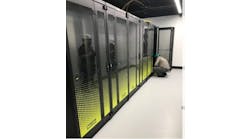Understanding the Types of Interconnection, and When to Use Them
A new special report from CoreSite and Data Center Frontier explores how colocation can be the “nervous system” of today’s modern digital businesses. The fourth entry in this special report series offers a better understanding of interconnection, different types, and the reasons behind using a colocation provider for interconnection services.
Get the full report. (Report Cover Image: Kkssr/Shutterstock)
Understanding Interconnection
Interconnection refers to physical and virtual data connections between companies that enable the rapid exchange of data. Colocation and interconnection have been inseparable since the early days of the industry, but the interconnection component is growing as connectivity becomes an important a driver of the colocation decision for cost, security and scalability reasons.
Colocation provides a central meeting place for networks, clouds and enterprises to host their physical infrastructure and interconnection enables them to efficiently exchange traffic with one another. Selected IT services from business partners can be physically located in a colocation facility for maximum performance.
This approach takes advantage of the fact that colocation facilities are optimized to house multiple customers. Those customers can connect with each other over many different mediums including Ethernet to enable data exchange at extremely high speeds and at low cost without the latency penalty of public networks or the cost of private leased lines from an on-premises data center. Accessing the cloud via dedicated connections within a colocation facility can cut bandwidth costs by 60% compared to using the public Internet.
Interconnection has grown in importance as cloud usage has expanded and diversified. Companies now use an average of 2.3 infrastructure-as-a-service providers and two platform-as-a-service providers. A Skyhigh Networks analysis of anonymized data from over 600 enterprises in 2016 found that the number of cloud-based applications in use had nearly tripled over a three-year period to an average of 1,427, a figure that is no doubt higher today.
All cloud and many SaaS providers use “on-ramps” such as Amazon Web Services’ Direct Connect or Microsoft Azure ExpressRoute to enable customers to establish dedicated connections between their networks and the cloud provider’s. Most of these on-ramps are actually routed through colocation facilities in order to reach the largest number of customers. Colocation providers partner with the big cloud platform providers to enable customers to establish private, low-latency network links between their dedicated infrastructure and cloud infrastructure providers for optimal performance of a hybrid IT environment. Customers benefit from reduced data transfer costs, improved security and optimal network performance along with the ability to connect to multiple cloud providers through a single interconnection point.
For example, the CoreSite Open Cloud Exchange enables direct, private, virtual connectivity into AWS, Microsoft Azure, Google Cloud Platform and Oracle Cloud. Customers have the flexibility to select speeds and connectivity options that meets their needs and to scale bandwidth as needed, all from a central console.
Customers using multiple cloud providers can enjoy access speeds equivalent to that of dedicated on-ramps along with the flexibility to switch sessions easily between cloud providers and transfer data with reduced egress charges, which can run as high as 12 cents per gigabyte.
Types of Interconnections
PEERING EXCHANGE
In a peering exchange, two networks connect and exchange traffic with each other without having to pay a third party such as a telecom operator or Internet service provider to carry that traffic across the Internet. The operator can adjust routing to avoid bottlenecks and optimize performance. Peering essentially keeps traffic local to avoid the latency caused by multiple Internet hops.
CROSS CONNECT
A cross connect is the equivalent of running a fiber or copper cable between each company’s servers. A physical, hardwired cable is provisioned between two different termination locations within the colocation data center, enabling high-performance, dedicated connectivity, excellent reliability and minimal latency.
INTER-SITE CONNECTIVITY
Inter-site connectivity provides communications between campuses in the colocation provider’s network. This enables customers to access all the providers they need in an interconnection-dense facility and to grow without constraints within campus facilities. A variety of carrier-grade transport options are provided as well as common-carrier access to other regional interconnection hubs that are ideal for remote locations.
BLENDED IP
A blended IP service provides the convenience of the colocation provider working with a variety of upstream carriers and ISPs to create a highly reliable, SLA-backed solution based on a fully redundant network architecture that provides the best performance across providers.
In addition, virtualized services like the CoreSite Open Cloud Exchange provide a platform for accessing multiple public cloud providers and connecting distributed deployments across multiple markets. Using inter-site connectivity, customers can build multi-region cloud architectures from a single port with no long-term commitments.
Why Use Interconnection Services from a Colocation Provider?
One of the most revolutionary concepts introduced by the cloud has been pay-as-you-go pricing. Today’s colocation services enable the same model to be applied to interconnection services so that IT resources can be provisioned and scaled up and down in a cloud-like manner with no long-term commitments.
Major colocation providers operate multiple large data centers with high-speed pipes between them. For latency-sensitive applications that require processing to be as close to the point of delivery as possible, such as edge computing and IoT environments, this distributed architecture offers customers more choices about how to deploy infrastructure. Instead of isolating IT resources in a single data center, compute and storage can be distributed across multiple colocation facilities for maximum speed and redundancy.
Interconnection enables data exchange between two or more entities or partners at the fastest possible speed by combining high-performance networks with physical proximity. Customers avoid having to work around the unpredictability of the public Internet and data communication costs are minimal.
Customers using multiple cloud providers can enjoy access speeds equivalent to that of dedicated on-ramps along with the flexibility to switch sessions easily between cloud providers and transfer data with reduced egress charges, which can run as high as 12 cents per gigabyte.
There are other reasons to consider interconnection services from a colocation provider:
- Customers have access to a wide range of third-party services that in the same facility that can be accessed directly through interconnection.
- Software-defined networking enables flexible control of connections, automated provisioning, network segmentation and security for distributed IT infrastructure via private SDN connections that bypass the Internet.
- Customers with multi-cloud and hybrid cloud architectures and/or multi-site needs can manage their cloud providers through a single console as well as consolidate billing.
- Many colocation interconnection services are connected directly to undersea cables, enabling the fastest possible data exchange with partners in other countries.
- Distributed colocation infrastructure is the ideal environment for organizations that are experimenting with edge computing, which moves processing close to endpoints and applies intelligence to manage traffic between endpoints, local processing resources and the cloud. Customers who begin using colocation services now will be better equipped to take advantage of these decentralized networks.
Catch up on the first three articles in the special report series below:
- Real-Time Business, Data Centers and the Colocation Solution
- 5 Common Colocation Myths
- Colocation: The Business & Technical Factors Driving Adoption
Download the full report, How Colocation Can Be the Nervous System of Digital Business, courtesy of CoreSite and Data Center Frontier, that explores how colocation might just be the answer to remain competitive in today’s markets.





